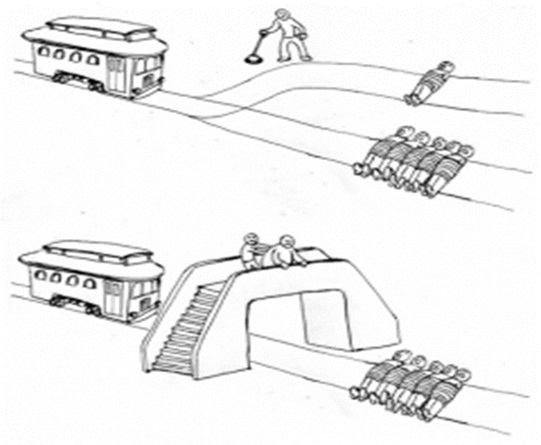|
26.10.8 NEEC 赤字はFredによる修正 トロッコ問題 (コメント) ―殺人に正義はあるか― 今回は、2012年1月23日号のNewsweek誌に掲載された、「正か否かの倫理的判断を瞬時に求められる時、人は理性よりも感情で動く」ことが、米ハーバード大学グリーン教授の実験で科学的に明らかにされたという記事がテーマです。これは、“トロッコ問題”として知られる古典的倫理問題に関する実験ですが、あの有名なハーバード大学のマイケル・サンデル教授が、殺人に正義はあるかというテーマで、学生たちにこのトロッコ問題を議論させる番組がNHKでも報道されましたので、ご存じの方も多いのではないかと思います。私はそもそも“トロッコ問題”について知らなかったので調べてコメントにしました。
|
|||
|
1.この記事で私が注目したのは、中ほどに記述されている「Greene put a new spin on a classic moral dilemma(グリーン教授、古典的な倫理の二者択一問題に新たな解釈を加える)」の一文である。グリーン教授の実験をより理解するためclassic moral dilemmaとは何なのか調べて見た。その結果、これはトロッコ問題あるいはトローリ問題と呼称されているもので、「一人を助けるために多数を犠牲にするのは許されるか?」という倫理学の思考実験を指す。 英国の女性哲学者フィリッパ・フット(倫理学分野における業績で著名、今日の道徳・倫理学を築いたうちの一人と目されている)が1967年に提起したもので、人間がどのように道徳的ジレンマを解決するかの手がかりとなると考えられており、道徳心理学、神経倫理学では重要な論題として扱われている。 著名なハーバード大学のマイケル・サンデル教授は「正義の話をしよう」と言う12回シリーズの講義の中で、第1回目の「殺人に正義はあるか」の講義でこのトロッコ問題をそっくり使用している。この記事ではトロッコ問題の一部が紹介されているが、その詳細は次のようなものである。
|
What I took note of in the article is
The trolley problem In his 12-lecture Even if part of the trolley problem is introduced in the article, I will explain it in detail.
|
||
|
「トロッコ問題」のイメージ図 #1オリジナル(上)と#2「太った男」(下)
|
|||
|
#1 オリジナルのトロッコ問題 線路を走っていたトロッコの制御が不能になった。このままでは前方で作業中だった5人が猛スピードのトロッコに避ける間もなく轢き殺されてしまう。この時たまたま貴方は線路の分岐器のすぐ側にいた。貴方がトロッコの進路を切り替えれば5人は確実に助かる。しかしその別路線でも1人の作業員が作業しており、5人の代わりにその作業員がトロッコに轢かれて確実に死ぬ。 貴方はトロッコを別路線に引き込むべきか?貴方は道徳的に見て「許される」か、「許されない」かで答えるものとする。つまり単純に「5人を助ける為に他の1人を殺してもよいか」という問題である。
#2 派生問題 では次のような派生問題ではどうだろうか?貴方は分岐器のすぐ側ではなく線路の上にある橋に立っており、貴方の横にC氏がいる。C氏はかなり体重があり、もし彼を線路上につき落として障害物にすればトロッコは確実に止まり5人は助かる。だがそうするとC氏がトロッコに轢かれて死ぬのも確実である。C氏をつき落とすべきか? なお、グリーン教授が実験で使用したのはこのケースと#1の分岐器の代わりにC氏の足元に落とし穴を設けたバリエーションである。
|
#1 The general case of the problem There is a runaway trolley barrelling down the railway tracks. Ahead, on the tracks, there are five people tied up and unable to move. The trolley is headed straight for them. You are standing some distance off in the train yard, next to a lever. If you pull this lever, the trolley will switch to a different set of tracks. However, you notice that there is one person on the side track. You have two options: + Do nothing, and the trolley kills the five people on the main track. + Pull the lever, diverting the trolley onto the side track where it will kill one person. Which is the correct choice?
#2 The derived case from the general case The initial trolley problem becomes more interesting when it is compared to other moral dilemmas. That is “The fat/large man” case, extensively analyzed by an American moral philosopher. This time, Professor Greene asked his subjects how they would respond to a moral dilemma using this “The large man” case in his experiment shown here. “The large man” case is as follows: As before, a trolley is hurtling down a track towards five people. You are on a bridge under which it will pass, and you can stop it by dropping a heavy weight in front of it. As it happens, there is a very large man next to you – your only way to stop the trolley is to push him over the bridge and onto the track, killing him to save five. Should you proceed? In addition, what professor Green used in the experiment is this case and its variant, placing a trap door beneath the large man instead of the lever in the case#1.
|
||
|
#3 類似問題 類似のケースとして次のような問題ではどうだろうか? それぞれ異なる臓器を必要としている患者が5人いるとする。これらの患者たちは、臓器移植を受けなければ死んでしまう。さて、今ここに健康な人が1人いて、この人は最初の5人が必要としている臓器をすべて持っているとする。しかし、必要とされている臓器をすべてこの人から取り出すと、この人は死んでしまう。この時、この人が結果として死んでしまうことになっても、臓器を取り出して5人の命を救うべきだろうか?
|
#3 An alternative case, but without a trolley: A brilliant transplant surgeon has five patients, each in need of a different organ, each of whom will die without that organ. Unfortunately, there are no organs available to perform any of these five transplant operations. A healthy young traveler, just passing through the city the doctor works in, comes in for a routine checkup. In the course of doing the checkup, the doctor discovers that his organs are compatible with all five of his dying patients. Suppose further that if the young man were to disappear, no one would suspect the doctor.
|
||
|
2.5人を助ける為に他の1人を殺してもよいか?
多くの人が、1番目のケースでは1人を犠牲にすることは許されると答えるのに対し、2番目、3番目のケースでは一人を犠牲にすることは許されないと答える。因みに、冒頭で述べたサンデル教授の問いかけに対するハーバード大学の学生の反応も概ねこの通りだった。 この3つのケースで異なる点は、ケース#1では行為者の行動自体は「分岐の切り替え」に過ぎず、1人の死は(たとえ結果を承知の上でも)その意図の直接の結果ではなく副次的な出来事(つまり巻き添え)と考えることが可能であるのに対し、ケース#2と#3では、はっきりと「狙ってある人間をトロッコに激突させる」「1人の健康な患者を殺す」という行動をとっており、行為者の直接の意図と行動によって死ぬということである。 フットがトロッコ問題を議論することよって指摘しようとしたのは、「死なせること(letting die)は殺すこと(killing)よりは道徳的に許される」とか、また「1人を犠牲にして多数を救う」とかいう考えは、実は曖昧で正確でないということである。即ち、いずれのケースも「一人を犠牲にして多数を救う」ことでは同じでも、道徳的に何をすべきかに関する直感的な判断はそれぞれのケースで全く違うのである。1番目のケースでは、一人を犠牲にすることは道徳的に許されるというのが直感であり、2番目、3番目のケースでは真逆で一人を犠牲にすることは道徳的に許されないというのが直感である。 この違いを説明するためにフットは「二重結果の原理(the doctrine of double effect)」と呼ばれる考えを導入した。この原理のポイントは、より大きな善を実現するために小さな悪が引き起こされてしまう時、この行為が“副作用”であるならば道徳的に許可されるが、それが“手段”であるならば道徳的に許可されない、という点である。トロッコ問題では、切り替え先の線路にいる作業員1人を殺すことは、線路にいる作業員5人を救うための手段ではなく、作業員5人を救うための行為の副作用だから、この場合は分岐器を切り替えることは道徳的に許されるという判断になる。逆に、2番目、3番目のケースは5人を救うという大きな善であったとしても1人を犠牲にすることが手段となっているため許されないと言うことである。
|
Whether sacrificing one person in order to save five people is allowed or not? Resistance to #2 and #3
course of action seems strong; most people who approved of sacrificing one to
save five in #1 case do not approve in #2 and #3 cases. Incidentally, at One clear distinction is that in #1 case, one does not intend harm towards anyone – harming the one is just a side effect of switching the trolley away from the five. However, in the cases #2 and #3, harming the one is an integral part of the plan to save the five, and this is wrong. What Philippa Foot was
going to say through dispute over the trolley problem is that thoughts /
views like “letting die is morally approved than killing” or “sacrificing one
person in order to save five people is allowed” are both not exact, but
ambiguous in fact. That is to say, “sacrificing one person in order to save
five people” is common to all 3 cases, but
|
||
|
3.グリーン教授の研究の斬新さは、classic moral dilemmaに関する伝統的な論争を、脳をスキャンすると言う方法で科学的に解明しようとした点にある。グリーン教授によれば、2番、3番のケースでは。1番目のケースと異なる脳の部位が反応するとのことである。つまり、人を直接死に追いやるとき、その部位が強く否定的な反応を示すようである。したがって人は実際にこのような場面に遭遇した場合、人は何もしないで5人を見殺しにする可能性が高いようである。 |
An uniqueness of professor Greene’s experiment is that he is trying to resolve this dispute by combining brain-scanning technology with classic experiments from moral psychology to provide a new look at how rationality and emotion influence moral choices. Unlike earlier philosophers, he could test his theories with neuroscientific instruments. His primary tool is functional magnetic resonance imaging (fMRI), which takes advantage of the fact that many mental functions are localized to specific areas of the brain. His work has led him to conclude that “emotion and reason both play critical roles in moral judgment. According to Professor Green, in the cases #2 and #3, a specific area of the brain differed from the way case #1 reacts. That is to say, the specific area seems to show strong reaction against deliberately killing the one. Therefore, when people actually encounter the cases #2 and#3, it is very likely that they will stand there doing nothing, and watch the five people on the main track die.
|
||
|
|
|
||
|
|
|
